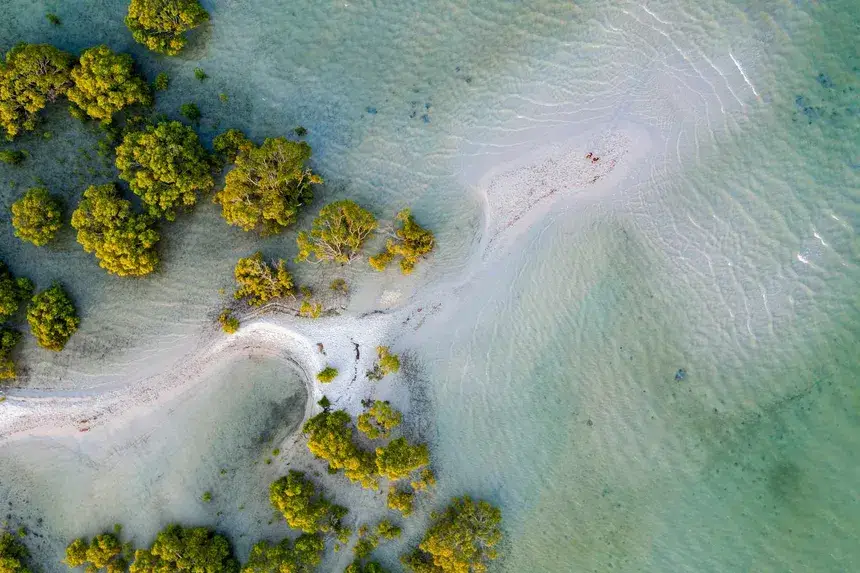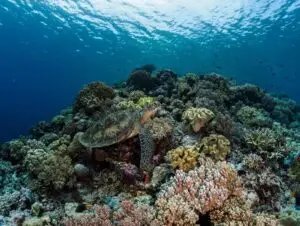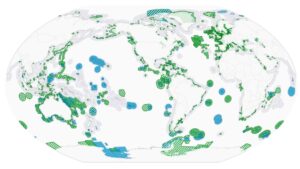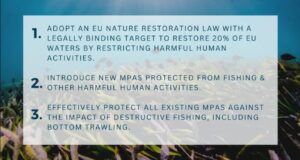by David FreedmanCoral Reef Conservation and Biodiversity Awareness | Early Career Ocean Professional (ECOP)
Blue carbon-carbon captured and stored by the world’s ocean and coastal ecosystems—has emerged as a powerful tool in our fight against climate change.
Research, as highlighted in the article from the National Center for Biotechnology Information (NCBI), sheds light on the critical role blue carbon ecosystems such as mangroves, seagrasses, and salt marshes play in reducing greenhouse gas emissions and promoting resilience in the face of climate challenges.
What is Blue Carbon and Why Does It Matter?
Blue carbon refers to the amount of which is carbon stored in marine ecosystems like mangroves, seagrasses, and tidal marshes. These ecosystems are capable of sequestering carbon at a rate up to ten times faster than terrestrial forests (Source: NCBI). Mangroves alone store approximately 1,000 metric tons of carbon per hectare, which can make them one of the most efficient carbon sinks on the planet.
Key Metric:
- Carbon Sequestration Efficiency: Blue carbon ecosystems capture up to five times more carbon per unit area compared to the amount tropical forests capture (Source: NCBI).
Example of Impact: If preserved and restored, mangroves could offset 1.4 billion tons of carbon annually, equivalent to the emissions from over 300 million cars.
Key Researchers and Projects in the Field
All across the world, researchers are working tirelessly to understand and leverage the potential of blue carbon. Key figures include:
- Dr. Carlos Duarte is a marine ecologist and one of the leading global voices in blue carbon research. His work has demonstrated the link between coastal ecosystems and carbon sequestration. You can follow Dr. Duarte’s work at KAUST (King Abdullah University of Science and Technology).
- Dr. Karen McGlathery from University of Virginia, whose research focuses on the resilience of seagrass meadows in mitigating carbon emissions and their role in ecosystem services.
Important Initiative to Watch: The Blue Carbon Initiative, spearheaded by Conservation International, the International Union for Conservation of Nature, and UNESCO, works to preserve coastal and marine ecosystems and incorporate blue carbon into climate policy frameworks globally.
Blue Carbon Projects as Part of Climate Policy
The recent paper highlights that including blue carbon in Nationally Determined Contributions (NDCs)— part of the Paris Agreement—could substantially boost our ability to reach international climate goals. Currently, only a handful of countries explicitly mention blue carbon in their NDCs, leaving substantial potential untapped.
Metric to Track:
- NDC Adoption Rate for Blue Carbon: As of 2023, only 11 countries have included blue carbon in their climate action plans, but initiatives are pushing to see this number doubled by 2026 (source: NCBI).
Example of Policy Adoption: Countries like Indonesia and Australia have been at the forefront of including blue carbon ecosystems in their climate strategies, thereby enhancing carbon sequestration and restoring critical coastal biodiversity.
The Future of Blue Carbon in the Blue Economy
Blue carbon initiatives also present a valuable opportunity for the blue economy. By monetizing carbon credits from restored coastal ecosystems, blue carbon can generate substantial financial incentives for conservation and community projects.
Potential Financial Impact:
- The blue carbon market could generate $6-10 billion annually by 2030, providing significant incentives for private and public sectors to invest in restoration and conservation efforts.
Case Study: The VCS (Verified Carbon Standard) certified mangrove restoration project in Kenya is a prime example. This project has sequestered over 500,000 tons of CO₂ and generated income through carbon credits sold to international buyers, benefiting local communities through job creation and enhanced resilience.
Challenges and Opportunities for Growth
While the promise of blue carbon is vast, several challenges remain:
- Data Gaps: More localized data on sequestration rates is needed to support precise policymaking.
- Protection vs. Development: Coastal areas are under pressure from real estate development, tourism, and agriculture, which makes protection efforts challenging.
Key Opportunity:
- Public-Private Partnerships: Establishing partnerships between governments, conservation organizations, and businesses can help strike a balance between economic growth and the preservation of blue carbon ecosystems.
The Blue Natural Capital Financing Facility is an initiative that facilitates such collaborations, and funding projects that enhance the blue economy while protecting ocean resources.
Blue Carbon as a Cornerstone of Climate Action
The findings shared in the NCBI article make it clear: blue carbon is not just a buzzword but a powerful tool for mitigating climate change and enhancing the resilience of vulnerable coastal communities.
By aligning blue carbon initiatives with global climate policy, supporting research, and creating incentives for the private sector, we can harness the full potential of our oceans to help build a sustainable future.
As Dr. Carlos Duarte eloquently said, “The ocean is not only our climate regulator, but it’s our future.”
Investing in blue carbon is an investment in our collective future—a future where climate resilience and a thriving blue economy go hand in hand.
Sources:
- NCBI Article on Blue Carbon Potential.
- KAUST. “Dr. Carlos Duarte’s Blue Carbon Research.”
- Conservation International. “The Blue Carbon Initiative Overview.”
- UNESCO. “Incorporating Blue Carbon in Global Climate Policies.”
- Blue Natural Capital Financing Facility. “Public-Private Partnerships for Blue Carbon Conservation.”




